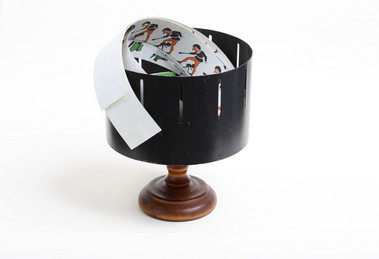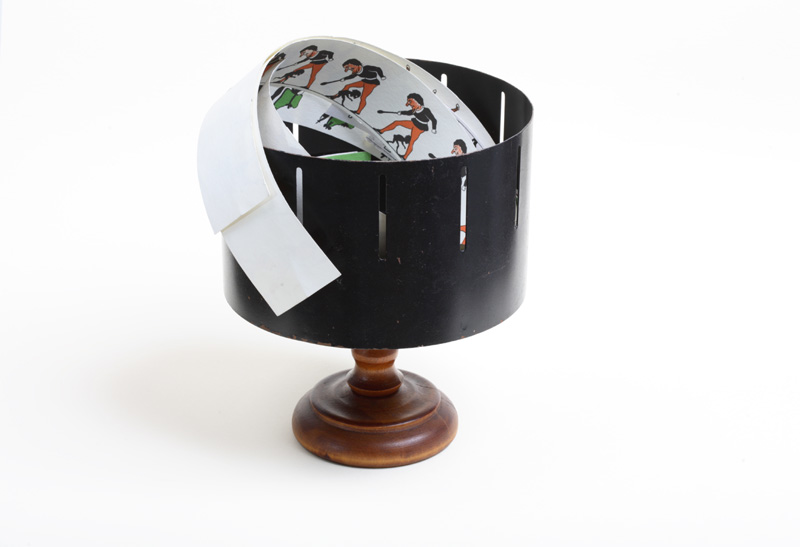Zoetrope, Victorian, Replica
Wealthy Victorians invented all sorts of amusements to entertain themselves at home. The zoetrope was a toy that seemed to make pictures move. It is usually said that it was invented in 1834 by George Horner, a British mathematician who was born in Bristol. He called his invention a "daedalum" or "daedatelum" (the wheel of the devil). It didn't become popular until the 1860s, when makers in both England and America patented it. The American developer, William F. Lincoln, named his toy the 'zoetrope', which means 'wheel of life'.
This replica version has a wooden pedestal with a slotted drum that spins on it. A strip of sequenced pictures is put inside the drum. As the cylinder spins, the viewer looks through the slits at the pictures on the opposite side of the cylinder. The slits keep the pictures from simply blurring together, so that the viewer sees a rapid succession of images producing the illusion of motion, the equivalent of a motion picture. The faster the drum is spun, the smoother the image that is produced.
Emile Reynaud in Paris adapted the zoetrope design in 1877 to form the praxinoscope. It used a drum, just as the zoetrope had. However, when the drum was spun, instead of through slits, the viewer watched the progression of images in mirrors. A candle set above the axle allowed the images to be seen more clearly.
All these early animated toys gave the inspiration for the creation of moving pictures based on real life. When it first became possible to take photographs fast enough to simulate a moving image, the cinema was born.
This replica version has a wooden pedestal with a slotted drum that spins on it. A strip of sequenced pictures is put inside the drum. As the cylinder spins, the viewer looks through the slits at the pictures on the opposite side of the cylinder. The slits keep the pictures from simply blurring together, so that the viewer sees a rapid succession of images producing the illusion of motion, the equivalent of a motion picture. The faster the drum is spun, the smoother the image that is produced.
Emile Reynaud in Paris adapted the zoetrope design in 1877 to form the praxinoscope. It used a drum, just as the zoetrope had. However, when the drum was spun, instead of through slits, the viewer watched the progression of images in mirrors. A candle set above the axle allowed the images to be seen more clearly.
All these early animated toys gave the inspiration for the creation of moving pictures based on real life. When it first became possible to take photographs fast enough to simulate a moving image, the cinema was born.

Height:14.5cm Diameter:43.5cm

Height:14.5cm Diameter:43.5cm

Wealthy Victorians invented all sorts of amusements to entertain themselves at home. The zoetrope was a toy that seemed to make pictures move. It is usually said that it was invented in 1834 by George Horner, a British mathematician who was born in Bristol. He called his invention a "daedalum" or "daedatelum" (the wheel of the devil). It didn't become popular until the 1860s, when makers in both England and America patented it. The American developer, William F. Lincoln, named his toy the 'zoetrope', which means 'wheel of life'.
This replica version has a wooden pedestal with a slotted drum that spins on it. A strip of sequenced pictures is put inside the drum. As the cylinder spins, the viewer looks through the slits at the pictures on the opposite side of the cylinder. The slits keep the pictures from simply blurring together, so that the viewer sees a rapid succession of images producing the illusion of motion, the equivalent of a motion picture. The faster the drum is spun, the smoother the image that is produced.
Emile Reynaud in Paris adapted the zoetrope design in 1877 to form the praxinoscope. It used a drum, just as the zoetrope had. However, when the drum was spun, instead of through slits, the viewer watched the progression of images in mirrors. A candle set above the axle allowed the images to be seen more clearly.
All these early animated toys gave the inspiration for the creation of moving pictures based on real life. When it first became possible to take photographs fast enough to simulate a moving image, the cinema was born.
This replica version has a wooden pedestal with a slotted drum that spins on it. A strip of sequenced pictures is put inside the drum. As the cylinder spins, the viewer looks through the slits at the pictures on the opposite side of the cylinder. The slits keep the pictures from simply blurring together, so that the viewer sees a rapid succession of images producing the illusion of motion, the equivalent of a motion picture. The faster the drum is spun, the smoother the image that is produced.
Emile Reynaud in Paris adapted the zoetrope design in 1877 to form the praxinoscope. It used a drum, just as the zoetrope had. However, when the drum was spun, instead of through slits, the viewer watched the progression of images in mirrors. A candle set above the axle allowed the images to be seen more clearly.
All these early animated toys gave the inspiration for the creation of moving pictures based on real life. When it first became possible to take photographs fast enough to simulate a moving image, the cinema was born.




















